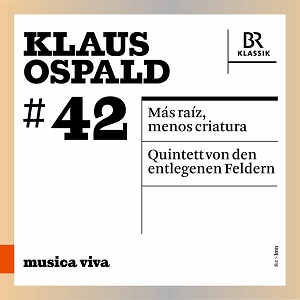
Klaus Ospald (b.1956)
Más Raíz, Menos Criatura (2014/5 rev. 2017)
Quintett von den Entlegenen (2012/13 rev.2014)
Markus Bellheim (piano)
Singer Pur, Bavarian Radio Symphony Orchestra/Peter Rundel (Más Raíz) Ensemble Experimental SWR Experimentalstudio/Peter Tilling (Quintett)
rec. live, 2019, Herkulessaal der Residenz, Munich (Más Raíz); Labor für Strömungstechnik und Hydraulische Maschinen der Hochschule Coburg
Reviewed as a digital download from a press preview
BR Klassik 900642 [82]
The title of the main work on this latest live recording from BR Klassik translates roughly, according to the sleeve notes, as “More root than man”. It sets a poem by the Spanish poet, Miguel Hernández from which that title is drawn. The central image that inspired this gripping work is of a child labouring in a field whose humanity has been so ground down that they are as much a part of that landscape as a human being. The title of the poem translates as “The Child as Draught Animal” which gives another perspective on the political dimension of the work. This might give the impression that it is a polemical work but that would be wholly incorrect. Ospald’s deeply affecting music is more the composer’s empathic response to that image and to all of the dehumanising exploitation that takes place around the world of which that image is a symbol.
The musical result of that empathy is to prevent the work becoming dry or ranting. Even though the tone is dark, the emotional tone is one of care and sympathy. Anyone who has ever been moved by a television charity appeal to help alleviate the suffering of child victims of war or famine will have little trouble identifying the mood of the piece. Ospald’s ability to evoke and sustain it is stunning even as his methods seem to be the standard bag of modernistic tricks. Sometimes those techniques can seem arid as if they are being deployed for their own sake but in this work technique is only incidental to what Ospald has to say. This means it is a work about sadness, suffering, hope and rage.
It features voice parts for a small chorus who carry the words but their voices are so integrated into the orchestral texture as to mimic the child disappearing into the landscape. They are certainly less prominent than the substantial solo piano part. In my imagination this functions as a representative of the composer commenting on and reacting to the more landscape-like contributions of orchestra and singers. Viewed simplistically, the work consists of alternating long quiet sections scored with consummate imagination by Ospald and more frenetic sections in which violence constantly threatens to break out. The tension of the piece is unrelenting presumably to bring to the listener the state of the burdened child.
The second work on this disc, despite being a quintet, is intended to be part of a trilogy on the same theme with Más Raíz Menos Criatura and a third chamber work. I found it a little curious that some way was not found to include the third part of the trilogy. Given how little attention is devoted to contemporary classical music I suppose I should be grateful for these two instalments!
This ‘Quintet from Remote Fields’ (to translate its title) is a much more abstract and opaque proposition. One of its most distinctive features is the use of live electronics which pick up, manipulate and represent through loudspeakers, the sounds made by the live instruments. In practice, the electronics provide a lot of the background ‘landscape’ that the orchestra produced in Más Raíz. Ospald’s use of it is subtle and understated and he integrates its sounds admirably into the textures of the live instruments.
I am left to assume that this piece too relates to the political poetry of Hernández that inspired Más Raíz though the sleeve notes do not make this clear. Certainly the mood is very similar even if the writing in the Quintett is more abrasive. Silence is an important part of Ospald’s sound world but perhaps more important are states in between silence and music – sounds hinted at, textures that emerge subtly out of and fade back into silence. The electronics play a crucial part in conjuring up this haunted musical hinterland. Rather fancifully I found myself thinking of the ghost of burdened child of Más Raíz.
Performances and recording are both top notch with Markus Bellheim particularly sensitive to the tone colours of the solo part in Más Raíz where others might have been tempted to hammer it out.
This is the first music by Klaus Ospald I have heard and it has made a very positive impression on me. This is tough modernist music but shot through with passion and imagination and a genuine desire to communicate important ideas.
David McDade


















